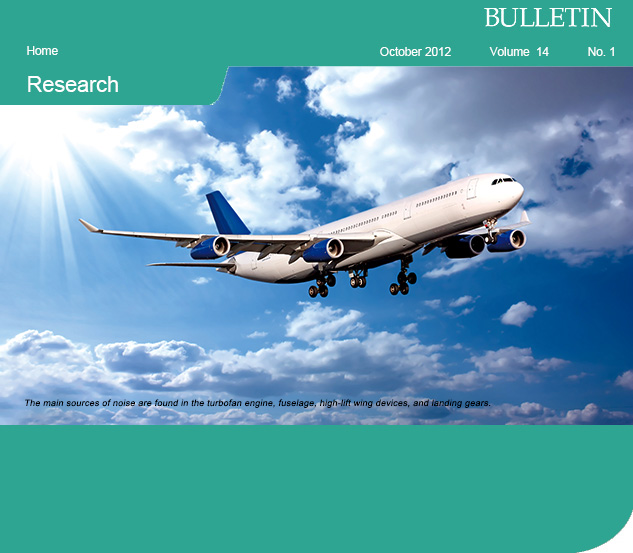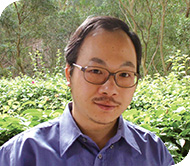| Turning down the Volume | |
| Passenger aircraft are one of the top focuses of China’s ‘973’ development project, and while the planes will be big the noise they emit will be small thanks to advances in aeronautic acoustics. |

|
|
Six years ago, China identified large passenger aircraft as one of its 16 priority endeavours – that is, an area where it wanted to gain expertise and manufacturing excellence. Large-scale nuclear power plant and the moon exploration are some of the others in the 16. For passenger aircraft, China aims, in the long term, to have its own company in the ranks of Boeing and Airbus. For Dr Huang Lixi, Associate Professor in the Department of Mechanical Engineering, this represented an opportunity to do advanced research in two of his areas of expertise, namely aeronautics and acoustics, as well as “to be part of a project that aims to build the expertise of a national team and to nurture new talents in this area who will contribute in future.” |

|
“Aerodynamics is not a big problem, there is plenty of expertise [in China]. But acoustic know-how is lacking.”
|
|||||
Working together with Professor Sun Xiaofeng of the Beijing University of Aeronautics and Astronautics (BUAA) and a team of other experts, Dr Huang applied for funding from China’s ‘973’ Programme, a massive enterprise launched in 1997 to organise, implement and fund basic research to meet the nation’s strategic needs. Since funding for 973 is only available to Mainland entities, the team applied for funding as a member of HKU’s Shenzhen Institute of Research and Innovation (SIRI). Their project, ‘Aeroacoustics and Advanced Noise Control for Large Passenger Aircraft’ is a five-year endeavour and gained RMB40 million in funding. The project is divided into five groups covering various different aspects of aircraft noise. “I am working on three of them,” says Dr Huang, “Group 2, fuselage noise, that is noise generated by the exterior body of the plane, including landing gears etc; Group 3, engine noise; and Group 4, cabin noise.” Since the funding stays in Shenzhen, Dr Huang is dividing his time between HKU main campus and SIRI. “The theoretical stuff we can do anywhere, but experiments must be done in Shenzhen. And when it comes to the Group 3 testing, we will use the national facilities with our Xi’an partners.” Noise Certification is a vital part of airworthiness testing for commercial airlines. International acoustics standards have to be met at take-off, flyover and landing measurement points before they are allowed to enter commercial service. For the development teams in China already working on large passenger aircraft, noise reduction is a weak point. “Aerodynamics is not a big problem,” says Dr Huang, “there is plenty of expertise in the country. But acoustic know-how is lacking.” So much so that it was identified in 2010 as an area which ‘973’ efforts needed to prioritise. Worldwide airplane acoustics are reaching a plateau [of low noise] where they can’t actually get much better, but not in China. Happy passengers “If you want to sell airplanes a prerequisite is satisfying noise regulations so that the plane is acceptable to people who live near airports or below flight paths,” says Dr Huang. “Interestingly, while noise levels within the plane should also be low enough to be comfortable to passengers, this is not actually a standard requirement – although of course it makes commercial sense to keep your passengers happy!” The main sources of noise in aircraft emanate from the engine (mainly the fan, compressor, jet turbulence), fuselage, high-lift wing devices and landing gears. In modern aircraft the engines are already much quieter than they used to be but it’s the auxiliary sources of noise that need attention. Dr Huang’s main areas of expertise are aeronautics and aeroacoustics – sound generated by fast air flow. He was educated at the Beijing University of Aeronautics and Astronautics, where he studied aerospace engineering (jet propulsion) and at Cambridge, where he diversified into theoretical acoustics and biomechanics. Noise control in humans While much of his career has concentrated on noise control in inanimate objects ranging from fans and ducts to buildings and aircraft, he has also ventured into the area of noise control in humans – in the form of snoring. “It’s the same principle,” he explains, “the vibrational soft palate works in the same way as air flowing over an airplane wing. In science things are often related that don’t seem to be in normal life. In the early 1990s, I worked on the mechanism of snoring and helped surgeons to devise a successful laser surgery procedure. It attracted a lot of publicity at the time – the BBC came and filmed us for a day – then did a The 973 aeroacoustics project has funding until 2016, and Dr Huang expects it to continue beyond that. “For China, this is the first major project to really concentrate on aircraft noise and it will need to be ongoing,” he says. And there are more aspects to pursue: “Within the project we are also concerned with vibration as a safety issue – making sure it is safe as well as being quiet,” he says, but is quick to point out that most noise from aircraft is made by airflow (aeroacoustics) – “It’s the air vibrating, not the wing!” |
| Back | Next |